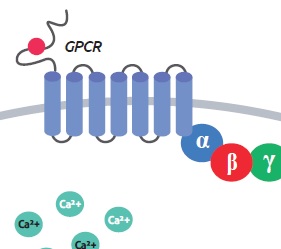Ion channels are proteins with pore-forming abilities. Their selective capabilities to let ions cross the cell membrane involves them in crucial cellular functions (controlling membrance potential, the flow of ions, regulating cell volume). Ion channels are involved in the patho-physiology of so many diseases, they are natural candidates for pharma R&D programs. We will review here a series of highly selective ion channel modulators which are ideal for performing drug discovery screenings.
Ion channels play an important role in perception and transmission of pain sensations. Furthermore dysfunctions of certain ion channels are involved in neuronal disorders, such as epilepsy, Alzheimer’s disease, Parkinson’s disease, schizophrenia, and many others. Mutations in ion channel genes have been linked to a wide varity of diseases like policystic kidney disease, cystic fibrosis, and total colour-blindness, to mention just a few.
Having access to characterized and selective ion channel modulators is thus crucial to better understand the role of these protein targets in diseases and to provide reference inhibitors in drug screening campaigns. Recently, Smartox has release a series of ion channel modulators as synthetic peptides derived from snake, spiders, mollusks and other venomous species.
Highly class-specific venomous Toxin ion channel modulators
14 Sodium channel synthetic peptide modulators
- Protoxin II: selective inhibitor of Nav1.7
- Protoxin II-biotin: selective blocker of Nav1.7
- Protoxin I: Blocker of voltage-gated sodium channels and T-type Cav
- Jingzhaotoxin-III: Selective blocker of Nav1.5 channel
- Hainantoxin-IV: Selective blocker of TTX-S VGSC
- Hainantoxin-III: Selective blocker of TTX-S VGSC
- Huwentoxin IV: TTX-S selective blocker
- Huwentoxin I: blocker of N-type Ca2+ channel and TTX-S channels
- μ-Conotoxin PIIIA: Blocker of Nav1.4 channels

TRPV1 ion channel. Brauchi S et al. (2007). - μ-Conotoxin GIIIB: Selective blocker of Nav1.4 channeted sodium channels
- GsAF-I: blocks voltage-gated sodium channels
- GsAF-II: Blocker of Nav1.1 / 1.2 / 1.3 / 1.4 / 1.6 / 1.7
- Phrixotoxin-3: Selective blocker of Nav1.2
- β-Pompilidotoxin: slows the inactivation of neuronal Navs
21 Potassium channel synthetic peptide modulators
- Iberiotoxin: Blocker of high conductance Ca2+-activated K+ channel
- Charybdotoxin: KCa2+channel blocker
- Scyllatoxin (Leiurotoxin-1): Modulator of SK channels (small conductance Ca2+-activated K+ channels)
- Tamapin: Selective blocker of SK2 (KCa2.2) channels
- Guangxitoxin 1E: selective blocker of Kv2.1 and Kv2.2
- ShK: Selective blocker of Kv1.3
- TMR-ShK: Fluorescent (red) Kv1.3 blocker

Mambalgin structure. Wikimedia Commons. - Margatoxin: Kv1.3 selective blocker
- HsTx1: Selective blocker of Kv1.3 channel
- Apamin: SK channel blocker
- Tertiapin-Q: Blocker of Kir Channels
- ADWX-1: Kv1.3 channel blocker
- Phrixotoxin-2: blocker of Kv4.2 and Kv4.3 channels
- (Dap22)-ShK: highly selective Kv1.3 blocker
- Agitoxin-2: Blocker of Kv1.1 and Kv1.3 channels
- AmmTx3: Blocker of A-type potassium channels
- BDS-1: selective blocker of Kv3.4 channel
- BeKm-1: Selective blocker of ERG1 channel
- Kaliotoxin-1 (KTX1): Potent blocker of potassium channels
- Maurotoxin: Kv and SK channels blocker
- Stromatoxin-1 (ScTx-1): Blocker of Kv2 channels
9 Calcium channel synthetic peptide modulators
- ω-agatoxin IVA: Blocker of P/Q-type calcium channel (Cav2.1)
- ω-conotoxin GVIA: selective blocker of Cav2.2 channel
- ω-conotoxin MVIIC: Blocker of P/Q and N-type Ca2+ channels
- Protoxin I: inhibits voltage-gated calcium and sodium channel
- SNX482: Selective blocker of Cav2.3 channel
- Maurocalcine: potent agonist of ryanodine receptors
- Huwentoxin-XVI: selective blocker of N-type Ca2+ channels
- ω Conotoxin SO-3: Selective blocker of N-type calcium channels
- ω-Conotoxin MVIIA: Blocker of P/Q and N-type Ca2+ channels
2 Chloride channel synthetic peptide modulators
- GaTx2: Selective blocker of ClC2 (CLCN2) chloride channels
- Chlorotoxin: Selective blocker of small conductance chloride channels
3 ASIC channel synthetic peptide modulators
- APETx2: ASIC3 selective inhibitor
- Psalmotoxin 1 (PcTx1): ASIC1a selective blocker
- Mambalgin-1: ASIC1a & 1b channel blocker
Mechanosensitive channels / TRP channel synthetic peptide modulator
- GsMTx-4: Selective blocker of mechanosensitive ion channels
Synthetic peptide modulator for Purinergic receptors
- Purotoxin-1 (PT-1): Selective inhibitor of P2X3 receptor channels
Interested in one of these ion channel active toxin for your in vitro assays?
Looking for custom production or additional modulators?
Get in contact through the form below.



